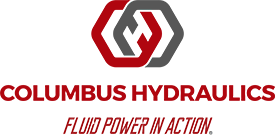Hydraulic cylinders are typically reliable parts that last several years in heavy machinery—but design flaws or improper care can lead to hydraulic cylinder leakage and the need to repair or replace these parts.
Prevention of hydraulic cylinder internal leakage happens at five points in the lifecycle of the hydraulic cylinder:
- Design,
- Manufacturing,
- Testing,
- Assembly, and
- Maintenance
For design, manufacturing and testing, it’s useful to know what processes your vendor puts in place to ensure quality. For assembly and maintenance, you’ll need to implement some simple procedures to keep your cylinders working for the long haul. In this article, we go through the specifics of preventing hydraulic cylinder internal leakage.
Design, Preparation and Welding Manufacturing for Leak Prevention
The best practices for manufacturing include a continuous improvement process. At Columbus Hydraulics, for example, the team has been developing and testing design tweaks that prevent leaks and that improve the long-term performance of hydraulic cylinders and seals. Keeping careful documentation and adhering to ISO standards means that the design team has precise records of the performance of every product and every product line. With accurate recording mechanisms, the company is able to track which design tweaks were most successful over the lifetime of each part, and integrate best practices that have continually improved our processes over the past decade.
The core welding process is a semi-automated process that uses a combination of automation and hand-welding. One of the most important steps in the process is preparing the hydraulic cylinder raw materials for welding. This involves creating a chamfer on the steel before the welding process, so that rather than welding two flat surfaces, there is already a fit for the end cap where there is a receiving groove for the material. As a result of the preparation process, welding is easier, and the result is a much more durable product. This process absolutely eliminates welding leaks.
Precision Seals
In addition to paying special attention to the preparation of grooves and chamfers, hydraulic cylinders require precision seals. Again, quite a bit of work goes into the design and preparation of the tubes to create airtight seals, and to the post-processing of the tubes after the seals are installed. Welding of the tubes creates a slight distortion which is invisible to the naked eye, but the tubes become slightly oval, which compromises the seal, which is perfectly round. In order to compensate for the distortion, after welding, the tubes go through a roller burnishing process which returns them to a perfectly round shape. The tubes then receive a surface finish before installing the seal. The optimal range for surface finish is 3-12 Ra microinches so that there is absolutely no room for leakage.
Some manufacturers put a very heavy emphasis on testing. Testing is essential, as we cover in the next section, but at Columbus Hydraulics, the heaviest emphasis is on the design and manufacturing. Getting these steps right means we rarely see any hydraulic cylinder leakage during testing.
Testing
Many manufacturers will use oil testing for hydraulic cylinders leakage tests, to replicate the operational environment. Air testing is quicker, cleaner and cheaper and better for identifying seal leaks, since air will escape even in places where oil might not. Every piece can be tested, or testing can be on a sample of every batch. A sample of parts is also sent for destructive weld testing with microscopic inspection, to ensure that every batch is perfect. At Columbus Hydraulics, we also employ a full-time on-site CWI inspector with years of training in identifying even the slightest anomaly.
Careful Assembly to Preserve Hydraulic Seals
Once the seals are shipped, assembling them into machinery is a fairly routine process. Manufacturers need to pay attention to the following two areas during assembly:
- Rod protection of the chrome
- Fittings from hose to cylinder
Any damage to the chrome on the rod can eventually evolve into rust which will corrode the seals over time. It’s important to avoid dropping, nicking or damaging the chrome in any way during assembly.
The fittings between the hose and cylinder are another area where equipment can experience leakage. Technically, this is not a hydraulic cylinder leak, but it can be misdiagnosed or blamed on the cylinder. Paying special attention to the fittings will avoid this problem.
Cylinder Care in the Field
Generally speaking, hydraulic cylinders do not require any maintenance in order to last for years or the lifetime of the equipment. The only exception is for equipment that is not in regular use, such as fire engines or farming equipment in the off-harvest season. Here, the danger is that the shaft does not get lubrication. A dry shaft is vulnerable to abrasion and moisture, resulting in rust. Simply running the equipment every two or three months to get the hydraulic cylinders moving will lubricate the shaft sufficiently to prevent this problem.
Conclusion
Hydraulic cylinder leakage is a periodic problem which can be avoided with proper manufacturing, testing, assembly and maintenance of cylinders. Like any machinery part, hydraulic cylinders do wear out over time, but purchasing high-quality cylinders and putting in place a few simple assembly and maintenance precautions will ensure the longevity and reliability of your equipment.


